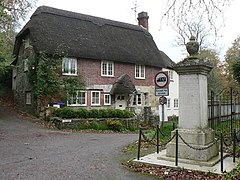Ebbesbourne Wake
| Ebbesbourne Wake | |
|---|---|
 War memorial and Old Forge Cottage, Ebbesbourne Wake |
|
| Ebbesbourne Wake shown within Wiltshire | |
| Population | 222 (in 2011) |
| OS grid reference | ST992242 |
| Civil parish |
|
| Unitary authority | |
| Ceremonial county | |
| Region | |
| Country | England |
| Sovereign state | United Kingdom |
| Post town | Salisbury |
| Postcode district | SP5 |
| Dialling code | 01722 |
| Police | Wiltshire |
| Fire | Dorset and Wiltshire |
| Ambulance | South Western |
| EU Parliament | South West England |
| UK Parliament | |
Ebbesbourne Wake is a village and civil parish in Wiltshire, England, approximately 10 miles (16 km) south-west of Salisbury. The parish lies near the head of the valley of the small River Ebble, and includes the hamlets of Fifield Bavant and West End.
It is not known when Ebbesbourne was first inhabited or what it was called but fragmentary records from Saxon times (circa 826 AD) indicate that the whole Chalke Valley area was thriving, and the village was called Eblesburna. It is surmised that the land adjacent to the bourne (river) was once owned by a man called Ebbel. Note that the word is derived from the Old English "brunna".
The Domesday Book of 1086 divided the Chalke Valley into eight manors: Chelke (Chalke - Bowerchalke and Broadchalke), Eblesborne (Ebbesbourne Wake), Fifehide (Fifield), Cumbe (Coombe Bissett), Humitone (Homington), Odestoche (), Stradford (Stratford Tony and Bishopstone) and Trow (circa Alvediston and Tollard Royal).
Peter Meers, in his book Ebbesbourne Wake through the Ages, translates the village's Domesday entry as:
Robert holds Eblesborne from Robert. Aluard and Fitheus held it before 1066 as two manors. (TRE = tempore Regis Edwardii, the time of Edward the Confessor, 1042-1066) Taxed for 14 hides.
Land for ten ploughs. In lordship ten hides, there six ploughs. Four slaves (serfs). Eighteen villeins (villagers). Seven [Serfdom#Bordars|bordars (smallholders)]] with four ploughs. Fourteen acres of meadow, pasture fourteen furlongs long, 4 furlongs wide. Woodlands two leagues length and width. Value £12, now £14.
...
Wikipedia

